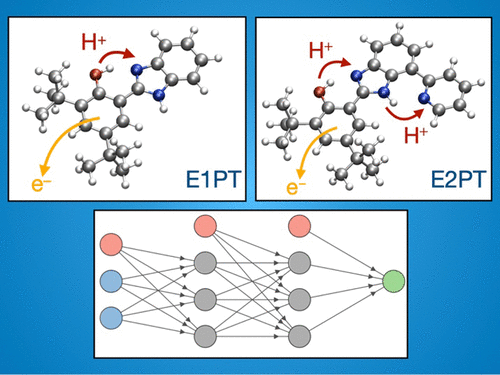当前位置:
X-MOL 学术
›
ACS Cent. Sci.
›
论文详情
Our official English website, www.x-mol.net, welcomes your
feedback! (Note: you will need to create a separate account there.)
Nonequilibrium Dynamics of Proton-Coupled Electron Transfer in Proton Wires: Concerted but Asynchronous Mechanisms
ACS Central Science ( IF 12.7 ) Pub Date : 2020-09-08 , DOI: 10.1021/acscentsci.0c00756 Joshua J Goings 1 , Sharon Hammes-Schiffer 1
ACS Central Science ( IF 12.7 ) Pub Date : 2020-09-08 , DOI: 10.1021/acscentsci.0c00756 Joshua J Goings 1 , Sharon Hammes-Schiffer 1
Affiliation

|
The coupling between electrons and protons and the long-range transport of protons play important roles throughout biology. Biomimetic systems derived from benzimidazole-phenol (BIP) constructs have been designed to undergo proton-coupled electron transfer (PCET) upon electrochemical or photochemical oxidation. Moreover, these systems can transport protons along hydrogen-bonded networks or proton wires through multiproton PCET. Herein, the nonequilibrium dynamics of both single and double proton transfer in BIP molecules initiated by oxidation are investigated with first-principles molecular dynamics simulations. Although these processes are concerted in that no thermodynamically stable intermediate is observed, the simulations predict that they are predominantly asynchronous on the ultrafast time scale. For both systems, the first proton transfer typically occurs ∼100 fs after electron transfer. For the double proton transfer system, typically the second proton transfer occurs hundreds of femtoseconds after the initial proton transfer. A machine learning algorithm was used to identify the key molecular vibrational modes essential for proton transfer: a slow, in-plane bending mode that dominates the overall inner-sphere reorganization, the proton donor–acceptor motion that leads to vibrational coherence, and the faster donor–hydrogen stretching mode. The asynchronous double proton transfer mechanism can be understood in terms of a significant mode corresponding to the two anticorrelated proton donor–acceptor motions, typically decreasing only one donor–acceptor distance at a time. Although these PCET processes appear concerted on the time scale of typical electrochemical experiments, attaching these BIP constructs to photosensitizers may enable the detection of the asynchronicity of the electron and multiple proton transfers with ultrafast two-dimensional spectroscopy. Understanding the fundamental PCET mechanisms at this level will guide the design of PCET systems for catalysis and energy conversion processes.
中文翻译:

质子线中质子耦合电子转移的非平衡动力学:协调但异步的机制
电子和质子之间的耦合以及质子的长程传输在整个生物学中发挥着重要作用。由苯并咪唑-苯酚 (BIP) 结构衍生的仿生系统被设计为在电化学或光化学氧化时进行质子耦合电子转移 (PCET)。此外,这些系统可以通过多质子 PCET 沿着氢键网络或质子线传输质子。在此,通过第一原理分子动力学模拟研究了由氧化引发的 BIP 分子中单质子和双质子转移的非平衡动力学。尽管这些过程是一致的,没有观察到热力学稳定的中间体,但模拟预测它们在超快时间尺度上主要是异步的。对于这两个系统,第一次质子转移通常发生在电子转移后~100 fs。对于双质子转移系统,第二次质子转移通常在初始质子转移后数百飞秒发生。使用机器学习算法来识别质子转移所必需的关键分子振动模式:主导整个内球重组的缓慢的面内弯曲模式、导致振动相干性的质子供体-受体运动以及更快的分子振动模式。供体-氢拉伸模式。异步双质子转移机制可以理解为对应于两个反相关质子供体-受体运动的显着模式,通常一次仅减少一个供体-受体距离。 尽管这些 PCET 过程在典型电化学实验的时间尺度上似乎是一致的,但将这些 BIP 结构附加到光敏剂上可以利用超快二维光谱检测电子和多个质子转移的异步性。了解此级别的基本 PCET 机制将指导催化和能量转换过程的 PCET 系统的设计。
更新日期:2020-09-23
中文翻译:

质子线中质子耦合电子转移的非平衡动力学:协调但异步的机制
电子和质子之间的耦合以及质子的长程传输在整个生物学中发挥着重要作用。由苯并咪唑-苯酚 (BIP) 结构衍生的仿生系统被设计为在电化学或光化学氧化时进行质子耦合电子转移 (PCET)。此外,这些系统可以通过多质子 PCET 沿着氢键网络或质子线传输质子。在此,通过第一原理分子动力学模拟研究了由氧化引发的 BIP 分子中单质子和双质子转移的非平衡动力学。尽管这些过程是一致的,没有观察到热力学稳定的中间体,但模拟预测它们在超快时间尺度上主要是异步的。对于这两个系统,第一次质子转移通常发生在电子转移后~100 fs。对于双质子转移系统,第二次质子转移通常在初始质子转移后数百飞秒发生。使用机器学习算法来识别质子转移所必需的关键分子振动模式:主导整个内球重组的缓慢的面内弯曲模式、导致振动相干性的质子供体-受体运动以及更快的分子振动模式。供体-氢拉伸模式。异步双质子转移机制可以理解为对应于两个反相关质子供体-受体运动的显着模式,通常一次仅减少一个供体-受体距离。 尽管这些 PCET 过程在典型电化学实验的时间尺度上似乎是一致的,但将这些 BIP 结构附加到光敏剂上可以利用超快二维光谱检测电子和多个质子转移的异步性。了解此级别的基本 PCET 机制将指导催化和能量转换过程的 PCET 系统的设计。











































 京公网安备 11010802027423号
京公网安备 11010802027423号